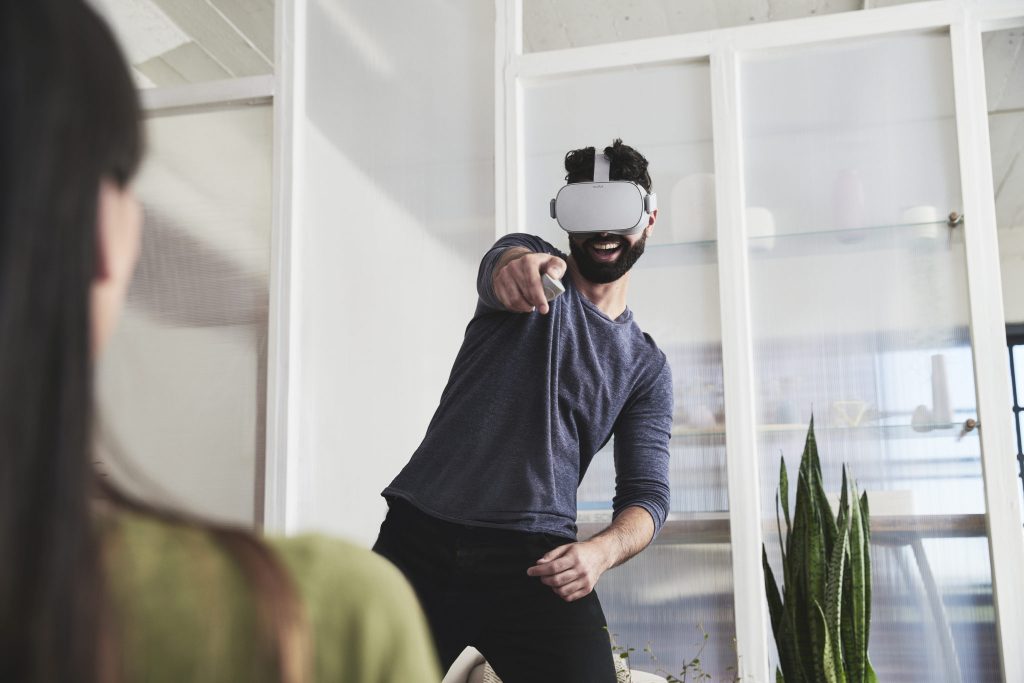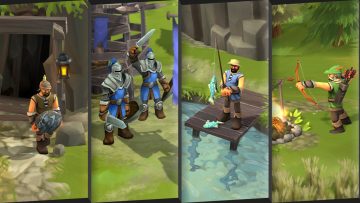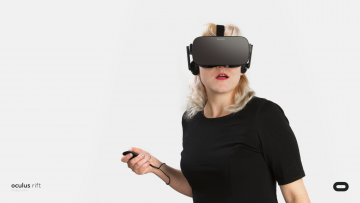
VR vs. On Speaking Terms
We are officially done with the Game Developers Conference, aka GDC for another year. Well, the one in San Francisco at any rate. I’d like to say the team are on their way back from it, no doubt laden with more interviews than you can shake a stick (with a camera on the end of it) at. But we’re heading hastily into another event this week courtesy of the fine ladies and gentlemen at NVIDIA. Here we go again, I guess.

GDC 2018 didn’t bring much in the way of truly big news. But then if the industry was, let’s say. a waveform of news we’re sort of in the trough at the moment. Waiting for things to begin building up again as we move towards the release of the standalone generation. That’s not to say GDC didn’t give us a lot to talk about. We got hands on with the Oculus Go, there was news from the three main engines, Peter and Kevin J got to try out a number of games that are on their way and we found out a little bit more about Magic Leap too. The announcement about support from Unreal Engine, made before the event, raised eyebrows. One user on Twitter put it that if it has UE4 support, then maybe it isn’t vapourware after all. The secrets and announcements are beginning to spill out of the company now, so it seems the Magic Leap One is definitely something we’re going to cover earnestly in the weeks and months ahead.
Today’s edition of VR vs. isn’t to do with that however, but more something that’s been in my mind for a while.
Terms, abbreviations and acronyms. We know there is virtual reality (VR), mixed reality (MR) and augmented reality (AR). There’s also a half-dozen immersive classifications sprinkled about the place. Other terms come and go in popularity. One that feels like it’s back on the rise is XR, I’ve certainly seen it used a lot more in the last couple of months than in the period before that. XR is most often expressed as meaning ‘eXtended reality’, out of place capital X (a conscious decision) included. That seems to have had a few definitions/variations here and there- the most common being either as a combination of elements from AR, MR and VR or as an umbrella term meaning all things related to the three – a reference to the spectrum of things. It’s one of the reasons, if you see any stories I write on VRFocus, you’ll often see me refer to things in the industry as relating to “immersive technology”. It just seems the easiest way to do so without getting potentially confused.
For a great article about XR Inputs incidentally, check out this article by James C Kane from about a month ago.
However, some companies like to muddy the waters of what existing terms and definitions are. Microsoft’s idea of what MR is – thanks to its naming of the Windows Mixed Reality headset range – doesn’t exactly help anyone. It’s effectively them going ‘yeah, we know that’s the definition but we define it as this other thing’. Then you have companies who, for branding, claim their product inhabits various other terms – Something-or-the-other Reality – purely for branding and trademarking purposes. These tend to come along in groups, and it feels like something of a grab on any poor letter of the alphabet that hasn’t been dragged off screaming. There is certainly enough kicking about the place to probably have a glossary of pointless terms.
To be clear to anybody currently considering concocting such a term for a product they are looking to market, you’re both a) not helping immersive technology in anyway by doing so and b) not fooling anyone either. Any idiot can make up something like that…
Fortunately, we have such an idiot on staff.
To prove how utterly pointless such an exercise is, I’ve come up with my own glossary of clearly highly serious and super official acronyms for the entire alphabet. Thus, all letters are now claimed. Sorry folks.
(For those of you interested in a proper glossary of the standard terms you can find such here.)
AR – Actual Reality: Development for this has been proven to be very slow and expensive, as opposed to developing it in/on a computer. However, the realism is second to none and it’s a proven market having existed for several million years. (Though some dispute this, citing other documentation.)
BR – Break Reality: Not to be confused with a reality that does not work. BR is, just ever so slightly lower than the reality that proceeded it. Usually by a few millimetres. Can be stacked.
CR – Counter Reality: Immersion that takes the present reality and reverses it in some form. With three forms of this officially defined as existing in a 2D plane with CR-X (a flipping of the horizontal), CR-Y (a reversal of the vertical) and CR-Z also known as CR-XY, which involves flipping along the diagonal). Attempts to define other sub-sections stopped at CR-ZY.
DR – Docēre Reality: A reality expressly concerned with the medical profession and that which operates ‘under the skin’ of the real world.
ER – Emergency Reality: Same as above but for being developed in the Americas. Although in ER any app, program or managerial software undergoes regular drama and critical issues. Any programme you grow fond of will invariably have something catastrophic happen to it that may cause it to permanently leave the system save for flashback cameos.
FR – Réalité Français: Currently being promoted throughout Europe in the light of the ongoing Brexit negotiations, FR takes reality and just converts everything into French. C’est tout.
GR – Gigantes Reality: Applications using GR present virtual objects as real but at exactly 328% their usual size. Early reviews cite wondrous viewpoints not previously explored, although simple tasks such as opening doors in GR have proven difficult.
HR: Often a derisory term, in theory HR is an immersive technology based around organisational activity. In practice it appears to be a reality full of people and programmes that claim to know what they’re doing but very rarely seem to get things right. Often interfering with the work of functions that would invariably be fine without its presence.
IR – Iridescent Reality: IR experiences produce a reality where everything you see varies in colour according to the exact angle you are viewing it. Still experimental, it is not recommended in conjunction with fast movement.
JR: A now defunct reality that was, regretfully, terminated in the eighties. Though who pulled the trigger on it remains unclear.
KR – Kaleidoscopical Reality: No, this is nothing to do with a children’s toy. In KR, immersive experiences fundamentally alter their shape with every movement. Unfortunately, this means that in theory that one KR experience could become be any other KR experience. The technology is currently on hold, until legal guidance on how this affects copyrights is sought.
LR: Truncated abbreviation of Long Range Ruling Reality or ‘LRRR’, a future-based reality tech, set to conquer the world but with an expected development time of just under 1000 years according to predictions from the Omicron Persei 8 Foundation. Will probably destroy you.
MR – Mirror Reality: Owing to the present level of technology (at the time of writing) an imperfect reflection of what is expected in reality – not to be confused with CR. MR applications and experiences tend to be ultimately disappointing and often involve shiny tops and sashes as well as the addition of a black goatee beard to everything.
NR – Non-Reality: Sometimes called ‘Counter-Immersive Reality’ – again, not to be confused with CR. NR is a response to safety concerns and implications of VR and AR, and whether or not experiences can become so immersive as to appear as actual reality. All virtual objects within NR simulations are officially branded as ‘not being real’ with audible warnings declaring the objects to be not real and visible warning stickers. The stickers naturally all have warning stickers and full disclaimers themselves. As do those stickers – and so on.
OR – aka ‘Substitutive Reality’: A proposed reality presented as an alternate choice to that originally represented.
PR – Public Reality: A reality comprised of what is recommended as being best for you, as determined by marketing committee.
QR – Quick Reality: Another now rarely used iteration of immersive technology, which presents reality a series of squares filed, in turn, with other squares of black and white. Representations can be translated through a camera with correct software on it, however locating one is difficult owing to all such virtual cameras also being patterned squares within the QR space.
RR – Radiolucent Reality: Immersive experiences which are not affected by radiation in any way, meaning your enjoyment is not spoiled in the event of any kind of radioactive spill or nuclear fallout. As proved by the colossal amount of radiation you are subjected to by the experimental plutonium powered RR headset.
 SR – Subjective Reality: A personally tailored reality that automatically is shaped to the will of the headset wearer, responding to their emotional state and biological responses.
SR – Subjective Reality: A personally tailored reality that automatically is shaped to the will of the headset wearer, responding to their emotional state and biological responses.
TR – Taciturn Reality: An in-depth immersive experience that ultimately tells you nothing at all.
UR: A reality with no defined set of rules. Whatever you choose this reality to be it won’t judge you.
VR – Versatile Reality: Immersive technology that creates a representation over the real world which is malleable. Of course, the reality underneath that is still solid, so finding a use for this has so far been troublesome, despite its name.
WR – aka ‘Guinness Reality’: A somewhat quirky implementation of immersive reality, WR operates as in true reality except values within it are dictated solely by the ‘best’ defined value from the real world. So whilst free-movement is supported people can only be stationary or move as fast as the fastest person alive with no middle ground. In the same way as a car can either be at 0 miles per hour (mph) or around 270 mph, the approximate speed of the fastest car in the world. Constantly being updated experiences become better/worse, depending upon your point of view, as values change in reality.
XR – XTREME Reality: Immersive technology that turns everything into a representation of the 1990’s. Signs seem to entirely consist of incorrectly spelt words, often remaining in motion on a background made up of a series of random neon coloured shapes stuck on a rectangle of another colour. Most characters in current XR games seem to sport bucket hats, denim dungarees and trainers with flashing lights in them. Hard Rock Cafe XR is particularly popular, which is to say that it is “radical”.
YR: Endlessly argued over, YR is a reality constantly in a developmental state as people debate whether it should even exist in the first place. Forums have threads entirely devoted to trying to get the platform out of the loop it finds itself in. Hence the slogan “YR? Indeed.”
ZR – Zero Reality: ZR experiences express all objects as other objects, never what it in fact is. So, a banana could be anything, at least in theory, except for a banana. There is a standard rulebook for ZR, indicating what item is supplanted by what. However, it is believed that Microsoft are making up their own non-standard version. Also known as ‘Illusion Reality’ owing to the fact that ‘nothing is as it seems’.
There we go – utterly ridiculous. Fun to write, certainly, but ultimately they mean nothing; and that’s exactly what these new terms created for branding all generally mean. Nothing. Let’s stick with what we’ve got and if the time comes where things evolve enough to warrent a redefinition we can do that.
Until that time though…
This post was originally written by the author for VRFocus.





![Private: [ID: _ysslzefllQ] Youtube Automatic](https://lastminutecontinue.com/wp-content/uploads/2024/10/private-id-ysslzefllq-youtube-au-360x203.jpg)
